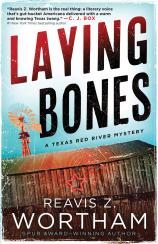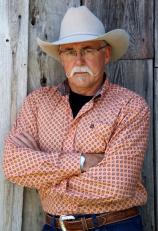Interview: January 15, 2021
Reavis Z. Wortham is the critically acclaimed author of the Red River Mysteries, which takes place in rural Northeast Texas in the 1960s, and a contemporary thriller series featuring Texas Ranger Sonny Hawke. In this interview conducted by Michael Barson, who has worked in book publicity since 1984, Wortham talks about the fascinating research he conducted for LAYING BONES, the eighth and latest Red River mystery; his decision to have these books progress one year at a time throughout the ’60s; which of his characters are inspired by people from his own life; the top five authors in his personal Texas Novelists Hall of Fame; and what readers can look forward to in future installments of the Red River series.
Question: You note that LAYING BONES, which is set in 1969, is based on a tragic event that dates from 1964, which you recalled from your childhood. Once you decided to make this crime the basis for the new book, how did you go about researching the actual details to make certain you had them right?
Reavis Z. Wortham: Great question!
My dad’s best friend was R.B. He died under questionable circumstances in 1964, and I didn’t know there were suspicions about his death until two years ago when I was talking to one of my cousins at a funeral. I mentioned that Dad talked about R.B. until the day he passed away. All those years, Dad struggled with the manner and suddenness in which R.B. passed away. When I mentioned that, the relative I was talking to gave me a strange look.
“Rev, R.B. didn’t drown in that creek. It was almost dry, except for a few places where the water was less than an inch deep. Dad (who was then a deputy sheriff) saw the autopsy report. There was no water in his lungs. Something happened that night when he drove off that little bridge in the creek bottoms, but it wasn’t an accident.”
There are more questions than answers. Using that as a framework for LAYING BONES, the eighth novel in the Red River series, I developed my own ideas about what might have happened that cold winter night.
I grew up in the area and used history from 1969, and took it from there. There was no research on the incident itself, because there were no notes, arrests or reports. All those old men and family members who shared their grief together are gone now, so the few facts and suppositions led me to ask myself, “What if?”
The true research came with the other storyline. Most people believe the borders that separate our states are fixed, and they are as solid as the lines on a map, unless you consider the rivers. These waterways move, though not as much as they once did now that dams and locks control much of the flow, but the Red River refuses to be tamed.
If you look at a Google map, you’ll find that thin portions of Texas and Oklahoma are technically in the other state. When I realized that a strip of Oklahoma was on the Texas side of the river and inaccessible to our neighboring state, I asked myself what would happen back in 1969 if someone built a honky-tonk on that strip of no-man’s land. My answer is LAYING BONES.
Q: LAYING BONES is the eighth novel in your Texas Red River Mystery series, which began with THE ROCK HOLE in 2011. What gave you the idea to have the books progress one year at a time throughout the ’60s?
RZW: I was a fledgling novelist at the time and didn’t know exactly what to do, so through inexperience I decided to advance the story a year at a time, not realizing that the series would be so successful and continue as long it has.
Looking back, I wish I’d advanced it in a more compact fashion, with two or three books in the series happening in ’64, ’65, etc. That way I could have explored more history and music of that time. However, it still works well because all my characters have a chance to breathe between crises. Though it’s fiction, constant bombardment of criminal events might have changed the tone of the story and characters.
We’ve been able to watch the kids Top and Pepper grow, and to experience more of life as it was back then. Now I’m considering the idea of inserting new novels into the existing timeline, because I don’t know if I want Top and Pepper to get much older. Their innocence is part of what drives the stories, and besides, the world after 1972 seems boring in a fictional sense.
Q: You dedicate LAYING BONES to the memory of your cousin Roger, a longtime friend who passed away in 2020. He had become the basis for the character Pepper in this series. How many of the other heroes and villains in LAYING BONES were inspired by people from your life?
RZW: That’s true. Roger was my running buddy and first cousin. We hunted, fished and experienced life together for years. But I didn’t want two boys driving the story at the outset. The cast of characters features Ned and Miss Becky, Top and Pepper’s grandparents. Their inclusion in the story gives us a viewpoint of those who lived through the Great Depression and the second World War.
Next comes Deputy John Washington and his view of Chisum and Lamar County through the eyes of an African American. Cody and Norma Faye provide a window of younger people who are carving out a life in the 1960s.
Here’s the interesting part --- Ned, Miss Becky and John Washington were based on real people, along with the two store owners Neal Box and Oak Peterson. My real Uncle Cliff appeared a couple of times in the series, as well as a local farmer, Floyd Cass.
Everyone else comes from my imagination, and that gives me quite a bit of latitude in story progression.
Q: The tone of the Red River mysteries is quite different from the one you utilize in your contemporary Sonny Hawke series. Do you ever experience any difficulty switching gears from one to the other, and have to stop writing to reboot yourself?
RZW: Not a bit! I get that question a lot, and I explain it this way. When you watch several TV series through the year, do you get confused about what’s happening? I bet you don’t.
That’s how it is with me. The Sonny Hawke contemporary series features my fictional Texas Ranger who is a trouble magnet. Sonny Hawke books being thrillers, we know the bad guy almost from the outset; we’re simply along for the fast-paced ride to the climax.
The Red River books are for the most part mysteries and flow so easily I don’t really have to think much about them. Drawing from experience, I include history and music, which is truly the magic time machine.
As I write the Red River books, I listen to music from the year I set the story. With Sonny Hawke, I play old Country music --- which is not to be confused with that bubble-gum rock and roll rap crap they call Country today!
Q: Before you even wrote your first book, was there one author you used to read regularly who became your inspiration for trying to write a mystery novel?
RZW: That’s a hard one, because I can’t narrow it down to one author. My favorite writer, and the one who helped spur me to write, is Robert Ruark. His book THE OLD MAN AND THE BOY truly impacted and guided my life, but he didn’t write mysteries. For that, I have to thank Donald E. Westlake. My third book in the series, THE RIGHT SIDE OF WRONG, was reviewed by Booklist; they gave it a starred review and said it was reminiscent of Westlake’s THE BUSY BODY and THE FUGITIVE PIGEON. What an honor that was.
But there are others who blended together in my head. Fred Gipson’s OLD YELLER,SAVAGE SAM and RECOLLECTION CREEK all combined with William C. Anderson and one of the funniest authors in America, Patrick McManus.
Q: Now that the Red River Mystery series has come to the end of the ’60s, do you plan to keep the series going a year at a time throughout the ’70s?
RZW: I’m afraid the kids will be too old by 1975. As I said in a previous interview, to me, the early ’70s, up to 1975, were the tail end of the previous decade, because so much of the civil rights issues, the Vietnam War and even the music were still feeding off those earlier roots. Now, I’m not sure what’ll happen after ’75, because that’s when disco came in, and I shudder to think of what could be after that.
Q: Who are the top five in your personal Texas Novelists Hall of Fame? And what is the greatest strength of each?
RZW: That’s easy. Here they are in order.
James Lee Burke is an author I strive to emulate. This soft-spoken author, whom I’ve only talked to on the phone, taught me how to advance a story at just the right time to build suspense, and to find the true beginning of a novel, excising extraneous material that is of no consequence. His descriptions of time and place are like no other writer. Most know of his Dave Robicheaux series, but also read any of his Hackberry Holland novels.
The aforementioned Fred Gipson. He was a master at putting readers in that particular time and place. He was expert at creating characters who are full of life and as real as anyone you’ve ever known. Read RECOLLECTION CREEK.
Jeff Guinn is that author whose nonfiction and biographies read like fiction. They grab readers and draw them in without effort. He moves back and forth between fiction and nonfiction without effort, and has penned excellent westerns. Read GO DOWN TOGETHER, the best book on Bonnie and Clyde I’ve ever read.
Joe R. Lansdale is the author of the Hap and Leonard series set in deep East Texas. He writes brilliant action full of humor. His characters are people you know, or have known. But he’s not limited to that series. He writes excellent stand-alones at an astonishing pace, and many have been optioned for the movies. Read THE BOTTOMS and COLD IN JULY.
Melissa Lenhardt is seven novels in and making quite a name for herself. Not satisfied with any one genre, she created a hybrid called the feminist Western. Her female protagonists are gritty, gutsy and smart. She brings a female point of view that is both engaging and eye-opening. Read STILLWATER.
Larry McMurtry. No matter what he writes, he captures me in the first paragraph. He is brilliant at writing dialogue and description, and again, fully developed characters that you’d like to meet. Read LONESOME DOVE of course, but also try the superbly comic CADILLAC JACK.




